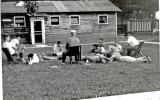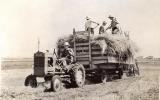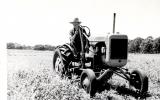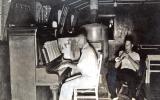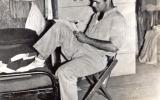CPS Unit Number 104-01
Camp: 104
Unit ID: 1
Operating agency: AFSC
Opened: 5 1943
Closed: 5 1946
Workers
Total number of workers who worked in this camp: 62
-
 CPS Camp No. 104Interior of CPS dorm.Digital image from American Friends Service Committee: CPS Records (DG002), Swarthmore College Peace Collection, Swarthmore, Pennsylvania
CPS Camp No. 104Interior of CPS dorm.Digital image from American Friends Service Committee: CPS Records (DG002), Swarthmore College Peace Collection, Swarthmore, Pennsylvania -
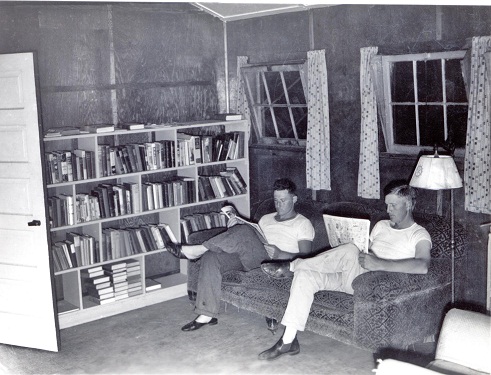 CPS Camp No. 104Camp Library; Walt Miller and Lee ‘Swede’ Carlson catch up on their reading.Digital image from American Friends Service Committee: CPS Records (DG002), Swarthmore College Peace Collection, Swarthmore, Pennsylvania
CPS Camp No. 104Camp Library; Walt Miller and Lee ‘Swede’ Carlson catch up on their reading.Digital image from American Friends Service Committee: CPS Records (DG002), Swarthmore College Peace Collection, Swarthmore, Pennsylvania -
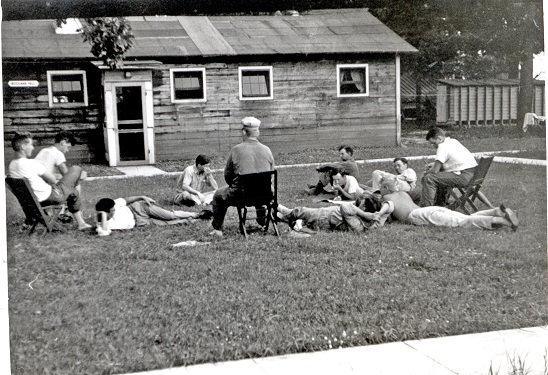 CPS Camp No. 104Camp meeting: matters of concern to campers are discussed at an evening meeting.Digital image from American Friends Service Committee: CPS Records (DG002), Swarthmore College Peace Collection, Swarthmore, Pennsylvania
CPS Camp No. 104Camp meeting: matters of concern to campers are discussed at an evening meeting.Digital image from American Friends Service Committee: CPS Records (DG002), Swarthmore College Peace Collection, Swarthmore, Pennsylvania -
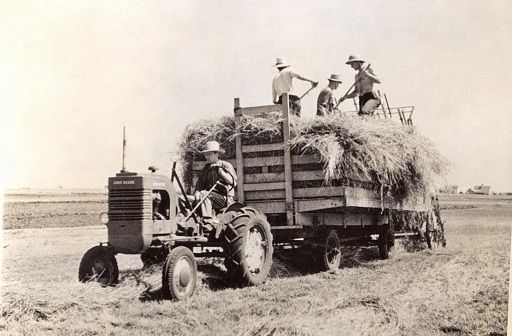 CPS Camp No. 104Project work: Al Osborne, Ed Northway, Lee Carlson, and Walt Miller.Digital image from American Friends Service Committee: CPS Records (DG002), Swarthmore College Peace Collection, Swarthmore, Pennsylvania
CPS Camp No. 104Project work: Al Osborne, Ed Northway, Lee Carlson, and Walt Miller.Digital image from American Friends Service Committee: CPS Records (DG002), Swarthmore College Peace Collection, Swarthmore, Pennsylvania -
 CPS Camp No. 104Project work: Miles Freeman and Don Regier hoeing soybeans.Digital image from American Friends Service Committee: CPS Records (DG002), Swarthmore College Peace Collection, Swarthmore, Pennsylvania
CPS Camp No. 104Project work: Miles Freeman and Don Regier hoeing soybeans.Digital image from American Friends Service Committee: CPS Records (DG002), Swarthmore College Peace Collection, Swarthmore, Pennsylvania -
 CPS Camp No. 104Project work: Al Osborne mowing sweet clover.Digital image from American Friends Service Committee: CPS Records (DG002), Swarthmore College Peace Collection, Swarthmore, Pennsylvania
CPS Camp No. 104Project work: Al Osborne mowing sweet clover.Digital image from American Friends Service Committee: CPS Records (DG002), Swarthmore College Peace Collection, Swarthmore, Pennsylvania -
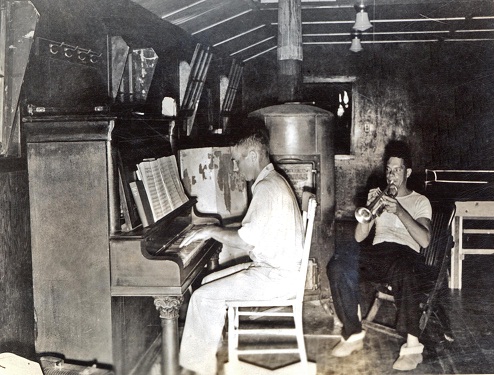 CPS Camp No. 104Recreation: Bill Bridges at the piano. John Staby, ‘that man with the horn,’ give out with a bit of ‘swing.’Digital image from American Friends Service Committee: CPS Records (DG002), Swarthmore College Peace Collection, Swarthmore, Pennsylvania
CPS Camp No. 104Recreation: Bill Bridges at the piano. John Staby, ‘that man with the horn,’ give out with a bit of ‘swing.’Digital image from American Friends Service Committee: CPS Records (DG002), Swarthmore College Peace Collection, Swarthmore, Pennsylvania -
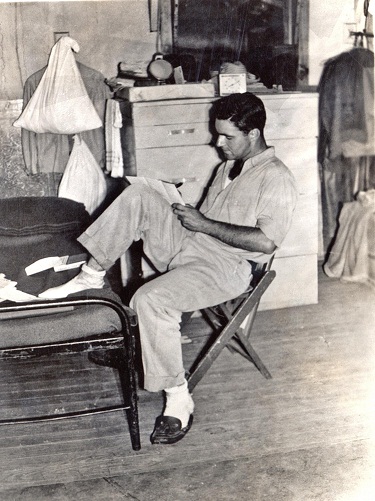 CPS Camp No. 104A letter to the folks at home: Corwin Matlock takes time out for letter-writing.Digital image from American Friends Service Committee: CPS Records (DG002), Swarthmore College Peace Collection, Swarthmore, Pennsylvania
CPS Camp No. 104A letter to the folks at home: Corwin Matlock takes time out for letter-writing.Digital image from American Friends Service Committee: CPS Records (DG002), Swarthmore College Peace Collection, Swarthmore, Pennsylvania
CPS Unit No. 104, an Agriculture Experiment Station unit at Iowa State University in Ames, Iowa operated by the Friends Service Committee (AFSC), opened in May 1943. When AFSC withdrew from CPS in March 1946, Selective Service administered the unit until it closed in May 1946. The men operated a crop-breeding program, cultivating small plots of different crop strains, testing and comparing plots.
The men also worked in side camps, one at Crystal Lake about one hundred miles north of Ames, where men worked in June and July with vegetables grown on a drained peat area. Another was at the Howard County Experimental Farm near Cresco, Iowa, studying soil drainage problems. (John Brush, July 31, 1943)
Directors: Alfred Johnson, Byron Thomas
The unit opened with ten men from Merom, Indiana. AFSC Correspondent John Brush wrote on July 31, 1943, “At a time when the need for agricultural labor in Iowa is so desperate that Jamaicans are imported and Italian prisoners-of-war are sent out under armed guard to the fields, it is easy to understand the welcome with which even conscientious objectors are met.” (Swarthmore College Peace Collection)
Fifty men comprised the unit, coming from various CPS camps.
More than the majority of the men are married. Most of the wives also fall in the category of mothers or are rapidly achieving that status. As a consequence, the interest of the men in camp is constantly drawn outside and is focused on their home activities. The problem of wives at Ames is an ancient and perplexing one and need not be expanded here, other than to say that the situation has been met in part by placing most of the married men and their mates in the summer side camp locations. Any man who goes to a side camp can live with his wife, generally in a separate house, in conditions which I think are singularly favorable for men under the assignment. (Samuel D. Marble visit report Aug. 1, 1945, Swarthmore College Peace Collection)
Men in Friends units tended to represent the greatest diversity with respect to religious identification. Few men in AFSC camps and units reported Friends denominational affiliation and it was not uncommon for the group to include men from a variety of religious groups as well as COs reporting no religious affiliation.
In Friends projects, men on average had completed 14.27 years of educational experience, with forty percent of the men having completed both college and post graduate education. Forty-three percent of men in Friends camps and units entered CPS with technical and professional work experience, as opposed to eighteen percent among men at Brethren and twelve percent in Mennonite projects. Men in the Friends projects tended to report more urban than rural experience. (Sibley and Jacob pp. 170-172)
Fifty men cultivated small plots of different strains of seed, testing and comparing results with other experimental plots. Their service permitted the continuation of long-range experiments designed to improve the quality and yield of food stuffs and greater productivity in livestock.
During the winter, men rotated through a variety of divisions in the Agricultural College—“Seed Analysis and Testing Laboratory, Agricultural Engineering, Farm Crops, Soil Science, Botany, Horticulture, Plant Chemistry, Genetics, Home Economics, College Publications, College Farms, Bacteriology, poultry farm, dairy farm, and swine farm”. (Edward P. Thatcher, February 20 ?)
During July and August, men helped in corn detasseling and pollination. “Hybrid corn offers one of the best examples of the value of research in practical agriculture. . . . Pollination, which must take place under carefully controlled conditions, requires a great deal of hand labor at the stage when the tassels are appearing and the silks emerging from the ears. Approximately 74,000 hand pollinations are made annually at the station. The result of such labor has been the steady improvement of one of the most important crops in the nation.” (Brush, August 15, 1943)
For the men, the work though difficult, proved more meaningful as it contributed to the food supply and exports to the starving in Europe and Asia. In addition, their work contributed to the development of knowledge and techniques to speed agricultural rehabilitation in war torn areas.
“Old CCC buildings, obtained from a site some sixty miles distant, were sawed in half, moved on trailers, and set down in a grove on the Agronomy Farm, about two miles south of Ames. The housing facilities, when finally completed, will resemble closely the accommodations found in the CPS forestry camps. We enjoy secluded rural surroundings, but with ready access to campus and town.” (Brush)
Brush reported that the men were met everywhere with friendliness and interest, “. . . in contrast to the experience of some of us in other camps where public relations constitute a problem at times. . . . At the local FOR group, in the Quaker meeting, and in the Methodist church, men from the camp were welcomed and accepted into fellowship”. (Brush, August 15, 1943)
The unit did not set up a formal organization of social, educational, recreational and other activities because of their location near a college town.
The camp frequently entertained dairy testers from the Brethren units in training at Ames.
In the agriculture experiment station units, the college assumed basic financial responsibilities of the program. After determining the basic wage in the area for the type of worker in the unit, they then dispersed funds to cover room, board and laundry expenses. They forwarded the remainder to the National Service Board of Religious Objectors which paid other project expenses including a monthly allowance for each man to cover the cost of clothing and personal items, accident insurance, medical care and dental treatment and transportation to and from a project. NSBRO then forwarded any balance to the United States Treasury to be impounded in the CPS frozen fund. (Eisan pp. 254-255)
See John Brush, AFSC Correspondent, in Swarthmore College Peace Collection, American Friends Service Committee: Civilian Public Service Records (DG002), Section 1, Box 37a. www address?
For background information on agricultural units see Leslie Eisan, Pathways of Peace: A History of the Civilian Public Service Program Administered by the Brethren Service Committee. Elgin, IL: Brethren Publishing House, 1948, Chapter 7 pp. 239-272.
See Samuel D. Marble, visit report Aug. 1, 1945 in Swarthmore College Peace Collection, American Friends Service Committee: Civilian Public Service Records (DG002), Section 1, Box 37a. www address?
For discussion of CO concerns that pay might go toward war efforts, see Steven M. Nolt, “The CPS Frozen Fund: The Beginning of Peace-time Interaction between Historic Peace Churches and the United States Government”, Mennonite Quarterly Review 67 (April 1993): 201-224.
See Mulford Q. Sibley and Philip E. Jacob Conscription of Conscience: The American State and the Conscientious Objector, 1940-47. Ithaca, NY: Cornell University Press, 1952,including Chapter VII: The Service Record of the Conscientious Objector pp. 124-151.
Swarthmore College Peace Collection, Camp periodicals database.
Mss. article by Edward P. Thatcher, February 20, no year in Swarthmore College Peace Collection, American Friends Service Committee: Civilian Public Service Records (DG002), Section 1, Box 37a. web address


